A New Edition Considerably Enlarged. . .
A New Edition, Considerably Enlarged, of Attitudes Faithfully Copied from Nature and Humbly Dedicated to All Admirers of the Grand and Sublime (1807) is a brutal but scrupulously precise parody of the serious and influential publication by Frederick Rehberg based on the famous "Attitudes" of Emma Hamilton called Drawings Faithfully Copied from Nature at Naples and with Permission Dedicated To the Right Honourable Sir William Hamilton. . . originally published in Rome in 1794.
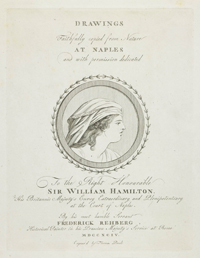
© Trustees of the British Museum. |
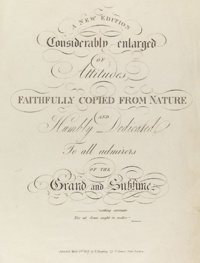
© Lewis Walpole Library, Yale University. |
Before she became the mistress and then the wife of the diplomat and archeologist Sir William Hamilton and later and more infamously the mistress of the British war hero Lord Nelson, Emma Hart was already a celebrated beauty, having appeared under many guises in numerous paintings by George Romney. Indeed Romney is supposed to have painted Emma more than sixty times between 1782 and 1786, often portraying her, as Reynolds was accustomed to doing with his sitters, as figures from classical history and mythology like Circe, Ariadne, Cassandra, and Diana.
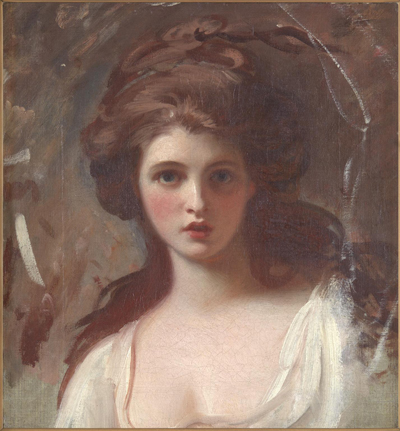
Emma Hart as Circe [1782]
© Tate Britain, London.
Already skilled in assuming personas from her work with Romney, Emma began in 1787 to perform what she called "Attitudes" for guests at Sir William Hamilton's villa in Naples, mimicking the forms and expressions of the classical figures in the paintings and on the vases he collected. According to the reports of contemporaries, these were not simply tableaux vivants, however, but more like early instances of performance art combining mime and dance so that one attitude morphed into another in a rhythmic, flowing pattern that was both aesthetically satisfying and emotionally compelling.
According to the German poet and novelist Goethe in his Italian Journey March 16th, 1787:
She lets down her hair and, with a few shawls, gives so much variety to her poses, gestures, expressions, etc. that the spectator can hardly believe his eyes. He sees what thousands of artists would have liked to express realised before him in movements and surprising transformations‐standing, kneeling, sitting, reclining, serious, sad, playful, ecstatic, contrite, alluring, threatening, anxious, one pose follows another without a break . . . This much is certain: as a performance it is like nothing you ever saw before in your life.*
Not surprisingly, Emma's performances attracted the attention of both artists and art lovers. So in 1791, Frederick Rehberg, a Prussian portraitist and drawing master, sought to capture some of the attitudes in the spare, Grecian style that was now beginning to be popular to record the antique images of Greek and Roman vases. With the help of Sir William, Rehberg published the resulting book of twelve attitudes with the fulsome title noted above. The book went through several printings, including at least one in London by S.W. Fores in 1797.
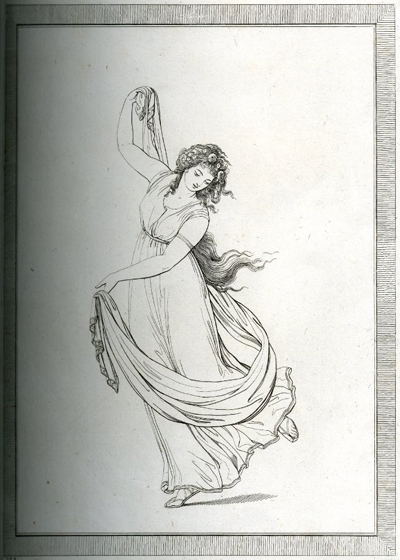
© Trustees of the British Museum.
Though by 1797, Gillray was working almost exclusively for Hannah Humphrey, it would not be totally surprising if he kept himself acquainted with the publications coming out of Fores' shop. And if so, he would have had the opportunity to see and purchase Rehberg's volume any time after 1797. Given the similarities between Rehberg's and Gillray's images, there can be no doubt that Gillray had a copy of Rehberg's work in his hands. The fulsome and ornate title page, the "framed" interior pages, the unadorned line, the attitudes included—all point to a cruel, but scrupulous, imitation/parody of Rehberg's volume.
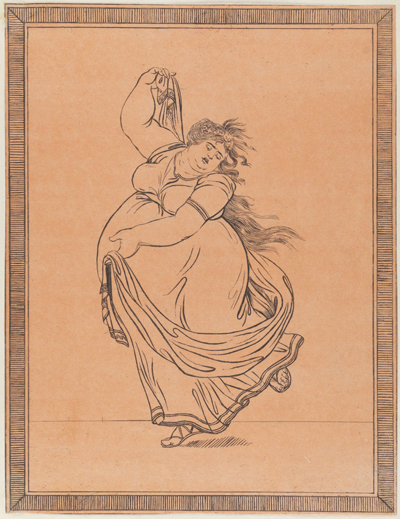
© Lewis Walpole Library, Yale University.
By 1807 when Gillray's parody appeared, Nelson had been dead two years from wounds suffered at the famous Battle of Trafalgar. But he and Lady Hamilton were still in the news. On January 18, 1807 Bell's Weekly Messenger published an extensive review of The Authentic Narrative of the Death of Lord Nelson by William Beatty, the ship's surgeon who attended Nelson on the H.M.S. Victory. It was just one of several reviews to appear over the next month, providing testimony that in his final hours Nelson was deeply concerned about Lady Hamilton and their daughter Horatia.
But also by 1807, Emma's love of liquor and luxury had significantly increased her waistline. In a word, she had grown fat. And Gillray, never loathe to caricature fat women, "enlarged" (as he would say) on that theme. From the title to the Preface to the twelve parody plates, Gillray pokes fun at Lady Hamilton's weight. Each plate of Rehberg's has a corresponding enlarged version in Gillray. Though a potent demonstration of how successfully he could mimick the style of another artist, Gillray's volume is finally a one note satire, technically nonpareil, but lacking the subtlety and ambiguity of his best work.
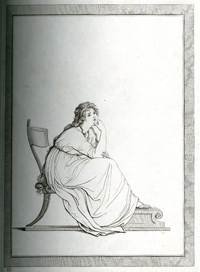
© Trustees of the British Museum. |
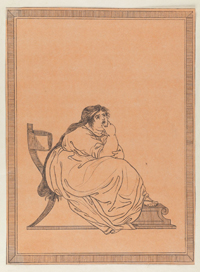
© Lewis Walpole Library, Yale University. |
* Quoted in the British Museum online entry for Rehberg's Drawings. . . .
Sources and Reading
- Commentary from the British Museum on Drawings faithfully copied from nature at Naples...
- The Emma Hamilton Society
- Nelson at Merton
- Emma at Home: Lady Hamilton and Her Attitudes
- "Friedrich Rehberg," Wikipedia
Comments & Corrections
NOTE: Comments and/or corrections are always appreciated. To make that easier, I have included a form below that you can use. I promise never to share any of the info provided without your express permission.